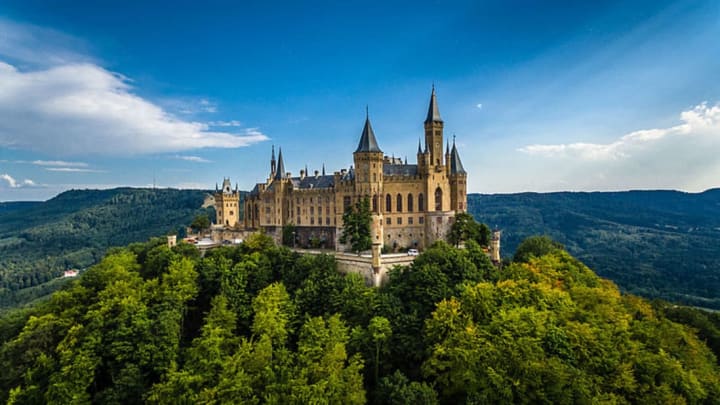Germany, in its many geographical and cultural incarnations, has always been both a crossroads and a political player in Europe. Over the past millennium, the nobility has responded to frequent wars, danger, and even wildlife by building large, sturdy castles—many of which survive today, and most are open for tourism.
1. MARKSBURG
Bytfisch via Wikimedia Commons // CC BY-SA 3.0
Marksburg Castle on the Rhine River in Braubach, Germany, has been occupied continuously for over 700 years. Construction began in the 12th century, and the castle was gradually expanded to its present size over the next several hundred years. It is open for tours, and it also serves as the headquarters for the German Castles Association. Yes, there are so many castles in Germany that the owners and preservationists have their own trade union.
2. SIGMARINGEN
Berthold Werner via Wikimedia Commons // CC BY-SA 4.0
Sigmaringen Castle in the Baden-Württemberg region of Germany was built for the Sigmaringen family, which eventually became a branch of the Hohenzollern family. The earliest part of the castle was built prior to 1077, the date of its earliest written reference. The castle has been expanded many times since then, but the original edifice still exists, buried under additional construction. The castle is owned by Prince Karl Friedrich of Hohenzollern and is open for tours.
3. REICHSBURG COCHEM
Holger Weinandt via Wikimedia Commons // CC BY-SA 3.0
Cochem Castle in Cochem, Germany, was built by Count Palatine Ezzo of Lotharingia, whose wife was the daughter of Holy Roman Emperor Otto II, around 1000 CE. That castle was traded among royalty until it was destroyed by King Louis XIV’s French forces in 1689. It lay in ruins for almost 200 years, until it was purchased by Louis Ravené, who had it rebuilt in 1868. Instead of the original Romanesque style, the new castle is mostly Neo-Gothic. It is open to visitors for guided tours.
4. CHARLOTTENBURG
Getty Images
Construction on Charlottenburg Palace in Berlin began in 1695 and was completed in 1713. During that period, Friedrich III of Brandenburg became King Friedrich I of Prussia, so his home became the royal palace. The palace is named for his wife Sophie Charlotte. It was the original home of the legendary Amber Room, built for Sophie Charlotte and given to Peter the Great of Russia in 1716. The room was installed in St. Petersburg until it was dismantled by German soldiers in 1941, and hasn’t been seen since.
Charlottenburg was mostly destroyed by British bombs during World War II. Berlin officials considered demolishing the remains, but since East Germany razed the Berlin Hohenzollern palace, they became determined to save Charlottenburg. The restoration is still ongoing, but visitors are welcome.
5. ELTZ
kaʁstn Disk/Cat via Wikimedia Commons // CC BY-SA 3.0 de
Eltz Castle is near Münstermaifeld, Germany. It is a complex of palaces serving different parts of the original family of the House of Eltz, first mentioned in official records in the year 1157. The manor house of that time, called Platteltz, has been added to over the centuries. The section called Rübenach house was completed in 1472. The Rodendorf house section was built over the next 50 years, and the Kempenich house was completed around 1530. The current owner is Dr. Karl Graf von und zu Eltz, part of the 33rd generation of the family to own Burg Eltz. The castle is open to tourists for part of the year.
6. HOHENZOLLERN
Marco Beck via Wikimedia Commons // CC BY-SA 4.0
Hohenzollern Castle near Hechingen, Germany, is the ancestral home of the royal Hohenzollern family of Prussia. The original castle was built prior to 1267, which is the oldest written reference found. It was destroyed in 1423 and rebuilt beginning in 1454, but that version fell into ruin after centuries of neglect. Crown Prince Frederick William of Prussia began a reconstruction in 1850. The castle, stilled owned by the Hohenzollern family, is open for tours.
7. LOHR
Sven Teschke via Wikimedia Commons // CC BY-SA 3.0 de
The Lohr Castle is in the town of Lohr am Main, Germany, and currently houses the Spessart Museum. This Bavarian castle was the birthplace of Maria Sophia Margaretha Catharina von Erthal, believed to be the inspiration for the Brothers Grimm tale "Snow White." To this day, the castle has a mirror on display known as the "Talking Mirror,” which Maria’s father bought for his new wife after her mother died. You know, her stepmother. Many such mirrors were made in Lohr, which was known for its fine glassworks. Lohr mirrors were said to “always speak the truth.”
8. PFALZGRAFENSTEIN
© MFSG via Wikimedia Commons // CC-BY-SA-3.0
While most castles are built as either a home or a fort, Pfalzgrafenstein Castle on the Rhine River near Kaub, Germany, is neither. It was built in 1327 under King Ludwig of Bavaria as a toll station. The well-fortified, boat-shaped edifice was built on a river island, and a chain from the station to the shores forced river traffic to halt and pay the toll. Armed men in turrets and a dungeon for uncooperative boatsmen helped Bavaria profit mightily from the control of the river. The castle is now a museum, reachable by ferry.
9. NEUSCHWANSTEIN
Jeff Wilcox via Wikimedia Commons // CC BY 2.0
Neuschwanstein Castle is not medieval, as construction began in 1869. King Ludwig II of Bavaria commissioned the building to resemble earlier German palaces. However, the result combines elements of Romanesque, Gothic, and Byzantine architecture. The king died in 1886, but construction of the palace went on until 1892. Neuschwanstein Castle is still not totally completed. The Sleeping Beauty Castle at Disneyland was modeled in part on Neuschwanstein Castle.
